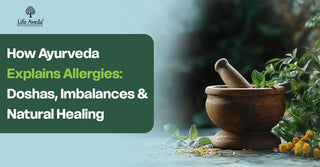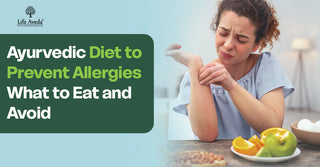Vitiligo is a pigmentation disorder affecting the skin, resulting in white spots on the skin. It is not dangerous to life but can significantly affect an individual's emotional and confidence levels. Contemporary medicine provides some treatments, yet increasingly, individuals are opting for Ayurvedic vitiligo treatment that uses the knowledge of herbs, food, and lifestyle habits to assist in the natural balance of the skin.
Among the many aspects of Ayurveda, diet plays a central role in restoring equilibrium in the body. The right foods can help purify the blood, strengthen immunity, and support pigmentation, while the wrong foods may aggravate imbalances and hinder skin health. In this blog, we’ll explore the association between vitiligo and diet, foods to eat and avoid, lifestyle practices, and how Ayurvedic treatment for vitiligo can complement your journey toward skin wellness.
Association Between Vitiligo and Diet
According to Ayurveda, vitiligo is caused by an imbalance in the body's pitta (heat energy) and the creation of ama (toxins). This imbalance interferes with the natural pigmentation of the skin and causes white patches.
- Diet has a direct effect on these factors:
- Certain foods detoxify and introduce equilibrium.
- Others can aggravate the imbalance and cause more loss of pigmentation.
This is why most Ayurvedic practitioners stress that Ayurvedic care for vitiligo must always start with the regulation of diet. In combination with herbal supplements and lifestyle changes, diet can be a very effective tool for skin health.
Foods that Support Skin Pigmentation & Immunity
A healthy, balanced diet is one of the strongest foundations of Ayurvedic treatment for vitiligo. Foods not only build up the resistance of the body but also contribute directly to skin repair, pigmentation, and cleansing. Let us delve into these food groups in greater detail:

1. Antioxidant-Rich Fruits
Fruits are nature's way of equipping the body with vitamins, minerals, and plant compounds that fight oxidative stress. Since oxidative stress has been linked to vitiligo, antioxidants become particularly valuable.
- Papaya: Hailed in Ayurveda as a natural detoxifier, papaya contains papain (an enzyme) and vitamin C. Both these substances aid in cleansing the digestive system, improving skin repair, and general glow.
- Pomegranate: This fruit has traditionally been used as a blood purifier. Its polyphenols, in particular, help to improve blood circulation, which is important for transporting nutrients to the skin.
- Figs: Figs contain a lot of dietary fiber and make digestion and cleansing simpler, and their antioxidants keep cellular damage at bay in the body.
- Apples: Apples are referred to as a "universal fruit" by Ayurveda. They soothe excess pitta, stimulate the body, and assist in skin nourishment.
- Bananas: They contain immediate energy, potassium, and beneficial vitamins that ensure healthy tissue growth and repair.
2. Detox-Supporting Vegetables
Vegetables, especially root vegetables and green leafy vegetables, take the leading role in flushing out toxins (ama), enhancing immunity, and nourishing skin.
- Spinach & Leafy Greens: Folate- and iron-rich, chlorophyll-rich leafy greens cleanse the blood and enhance oxygenation of the skin.
- Carrots: Packed with beta-carotene (a provitamin A), carrots safeguard the skin against oxidative stress and beautify the complexion.
- Beetroot: This beautiful root is a natural cleanser that improves blood circulation and brightens skin.
- Bitter Gourd (Karela): Bitter gourd, highly suggested in Ayurveda, carries very potent cleansing powers. It regulates the doshas of the body, nourishes the liver, and is said to maintain the complexion of the skin.
- Bottle Gourd (Lauki): Moisturizing and cooling, it aids digestion and drains excess heat from the body, thus reducing skin irritations.
3. Whole Grains and Legumes
Legumes and grains are a consistent source of energy, fiber, and nutrients. Digestion must be proper in Ayurveda since improper digestion creates an accumulation of toxins, which again affects the skin.
- Millets: Mild and fibrous, millets yield constant blood sugar levels and maintain the health of the gut.
- Brown Rice: Unlike white polished rice, brown rice retains its fiber and micronutrients, making it a better detoxifying and long-term energy source.
- Oats: As sedatives, oats are beneficial for gut health, which Ayurveda tends to correlate with skin health.
- Lentils (Moong, Masoor, Arhar, etc.): A good plant protein source, lentils are useful in tissue repair and immunity generation. Moong dal, in particular, is light, cooling, and easy to digest, and thus a frequent characteristic of Ayurvedic healing diets.
4. Herbs and Spices
Ayurveda places much dependence on herbs. They influence the inner levels of detoxification, immunity, and skin equilibrium. Following is a more detailed look at some of the strongest of them for vitiligo:
- Turmeric (Haldi): A classic anti-inflammatory and antioxidant, turmeric reduces free radical damage, maintains pigmentation, and cleanses blood. Its active ingredient, curcumin, has been widely known for its healing properties.
- Neem: Bitter in taste but strong in action, neem is referred to as a "natural purifier" in Ayurveda. Neem cleanses blood, combats infection, and revives skin health.
- Tulsi (Holy Basil): A sacred herb, tulsi has antioxidants and adaptogenic activity. It soothes the mind, enhances immunity, and keeps the skin healthy against stress.
- Manjistha: An age-old Ayurvedic herb for a healthy complexion, manjistha improves lymphatic circulation and supports detoxification. It is well adapted for regaining the original color of the skin.
- Giloy (Guduchi): Ayurveda has called Giloy "Amrita," as it enhances immunity, quenches inflammation, and triggers skin regeneration.
- Rosemary: More widely used today in herbalism, but still appreciated for its capacity to enhance blood flow and channel nutrients in the best possible way to the skin.
Dietary Items Which May Disturb Skin Balance
While nutritious food can nourish the body, there are foods that can disrupt skin balance and aggravate vitiligo. Ayurveda generally recommends avoiding the following:
- Junk and Processed Foods: Consuming foods rich in sugar, preservatives, and artificial flavoring leads to the production of ama (toxins) in the body. These toxins disrupt skin health and digestion.
- Excessive Sour and Citrus Foods: Although vitamin C is a must, Ayurveda opines that sour and citrus food items like vinegar, oranges, lemons, and pickles can, at times, aggravate pigment problems in vitiligo patients.
- Red Meat and Seafood: They are heavy to digest and, according to Ayurveda, also unsettle the doshas of the body. In patients with vitiligo, it may exacerbate skin sensitivity.
- Alcohol and Caffeine: Alcohol dehydrates the body, and excessive consumption of caffeine overexcites and exhausts the immune system. Both must be avoided or limited in managing vitiligo.
Lifestyle Changes + Herbal Support: A Complete Approach
Ayurveda teaches that healing isn't just what we eat—it's how we live. To individuals with vitiligo, adopting careful habits can allow for the proper space for the body to restore balance and guard the skin.

1. Hydration & Sun Protection
Healthy hydration flushes out toxins and nourishes the skin from the inside out. Ayurveda also suggests moderation in sunlight exposure—brief, gentle morning sun may be beneficial, but abrupt or extended exposure at peak times may reinforce depigmentation.
2. Stress Management
Stress is perhaps the most underappreciated cause of autoimmune diseases, such as vitiligo. Yoga, meditation, and pranayama are the recommended tools from ancient Ayurvedic texts for balancing the nervous system, reducing cortisol levels, and establishing harmony of body and mind.
3. Balanced Daily Routine
In Ayurveda, a healthy digestive fire (agni) is essential, as it aids digestion and keeps the digestive tract balanced and toxin-free. The individual's habits, like going to bed early, rising early, consuming freshly prepared meals, and not snacking in the late hours of the night, keep the digestive fire balanced. This stability is reflected directly on the skin.
4. Herbal Support
Ayurveda considers herbs as nature's gift for skin balance, cleansing, rejuvenating, and restoring natural pigment. Herbs are considered living energies that contain the healing intelligence of nature. Such an ideology lies at the core of Life Aveda's Vitiligo Care Pack, which harmoniously blends specially chosen herbs and oils to nurture skin health at all levels:
- Skin Vitals Capsules: An extremely potent combination of neem, turmeric, manjistha, tulsi, giloy, and rosemary that cleanses the blood, boosts immunity, and feeds skin cells towards a natural, healthy glow.
- Viti-Go Capsules: Enriched with bakuchi, neem bark, amla, haritaki, chitraka, and khair, these capsules help in pigmentation, digestion, immunity, and natural maintenance of skin balance from within.
- Babchi Oil: Babchi oil encourages natural pigmentation, smoothes out patchy skin tone, deeply moisturizes, and aptly complements inner herbs for holistic treatment of vitiligo.
There is no such thing as rapid relief for vitiligo, but there is a natural, holistic, and sustained Ayurvedic treatment for vitiligo that combines diet, lifestyle management, and the incorporation of herbs. The Life Aveda's Vitiligo Care Pack offers total support, which helps to purify the blood, improve immunity, equalize skin tone, and calm the mind.
Basic Diet Plan for People with Vitiligo
Here's a simple, implementable basic diet plan that you can follow to improve your skin health:
- Morning (Hollow Stomach): Turmeric or giloy juice with lukewarm water.
- Breakfast: Include oatmeal with berries or besan chila, soaked almonds with a fistful of papaya or pomegranate, and tulsi or rosemary herbal tea.
- Mid-Morning Snack: You can have juice, a fig smoothie, or coconut water.
- Lunch: Millet roti, spinach dal, beetroot salad, and carrot stir-fry.
- Evening Snack: A fistful of walnuts, figs, or an apple.
- Dinner: Moong dal khichdi with bottle gourd curry and steamed bitter gourd as a side.
- At Bedtime: A pinch of turmeric in hot milk or manjistha tea.
You can complement this diet with Life Aveda's Vitiligo Care Pack to ensure intense herbal nutrition for your body daily.
Conclusion
Vitiligo may not have an umbrella remedy, but a balanced diet, conscious lifestyle, and Ayurvedic herbal assistance can contribute greatly to the well-being of the skin. Antioxidant foods, cleansing vegetables, whole grains, and herbs can fortify the body, and eschewing processed, heavy, and excessively sour foods can eliminate imbalance.
When treating vitiligo with Ayurveda, it's always best with a whole approach. Life Aveda's Vitiligo Care Pack combines the synergistic action of herbs like neem, manjistha, giloy, bakuchi, and babchi oil to nourish pigmentation of the skin, immunity, and natural balance—internally and externally.
Take the entire journey with Ayurveda. Find out about Life Aveda's Vitiligo Care Pack and give your skin the care it so justly deserves.




